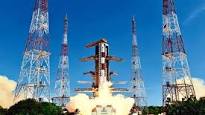ISRO to launch India’s heaviest satellite using launch vehicle GSLV Mark III D-1 today

ISRO to launch India’s heaviest satellite using launch vehicle GSLV Mark III D-1 today – 2017
THIRUVANANTHAPURAM:
As the countdown begins at 3.58 pm on Sunday for the launch of the Geosynchronous Satellite Launch Vehicle (GSLV) -Mark III from Sriharikota on Monday at 5.28 pm, ISRO centres behind the design of the launch indicate that in addition to being a human-rated vehicle, it marks the efforts of the ‘Make in India’ space project that’s fully indigenous and will be a major fete of self-reliance for the country.
Highlights:
- India’s heaviest rocket till date GSLV Mk-III weighs equivalent to the weight of five fully-loaded Boeing Jumbo Jets.
- It marks the efforts of the `Make in India’ space project that’s fully indigenous and will be a major fete of self-reliance for the country
“The focus of this first developmental flight of GSLV-MKIII (D1) set for launch on June 5, is to put a heavier communication satellite GSAT-19 in geosynchronous transfer orbit (GTO). It will be boosted by an indigenous cryogenic engine of an advanced version of 20 ton thrust.” ISRO CHARIMAN AS Kiran Kumar told TOI. The critical technology of the vehicle to carry heavy payload capacity, its design with acoustic suppression system would facilitate such future manned mission to space, he said.
The lead centre for ISRO launch vehicles, Vikram Sarabhai Space Centre (VSSC) director K Sivan told TOI that now the countdown has begun for the launch of GSLV-MK III on Monday at 5.28 pm and it is designed to put design to put four ton class heavy satellite in orbit. The launch vehicle in Ojive shape and slanted strap-on boosters rather than the usual straight format is to lessen noise. It could help in future manned mission, he said.
GSLV mission director G Ayyappan said, this GSLV-MKIII launch will mark the success of `Make in India’ space project with its fully indigenous launch in terms of the material, design and technology. Its unique features include the dual redundancy, health monitoring and fault detection and isolation (FDI). He also indicated that it is for the first time that a launch vehicle is designed with Ojive shaped curvature to be robust to control the air pressure and to check noise with its acoustic suppression system. Currently, the vehicle carries 3.2 ton, but with modular changes it can carry six tonnes, he said.
“With this launch, India need not depend on European Space Agency (ESA) for further heavy launch of INSAT-class satellites of 3.5 ton that incurs a cost of Rs 800 crore each. At one third the cost or at about Rs 350 crore, India can launch heavier satellites on GSLV-Mk III,” GSLV MK III Vehicle director J Jayaprakash told TOI. Till now, PSLV could launch around 1000 kg satellite, GSLV about 2000 kg and now with this GSLV-Mark III, India can launch heavy satellites of 4000 kg (4 ton) and above,” he said.






